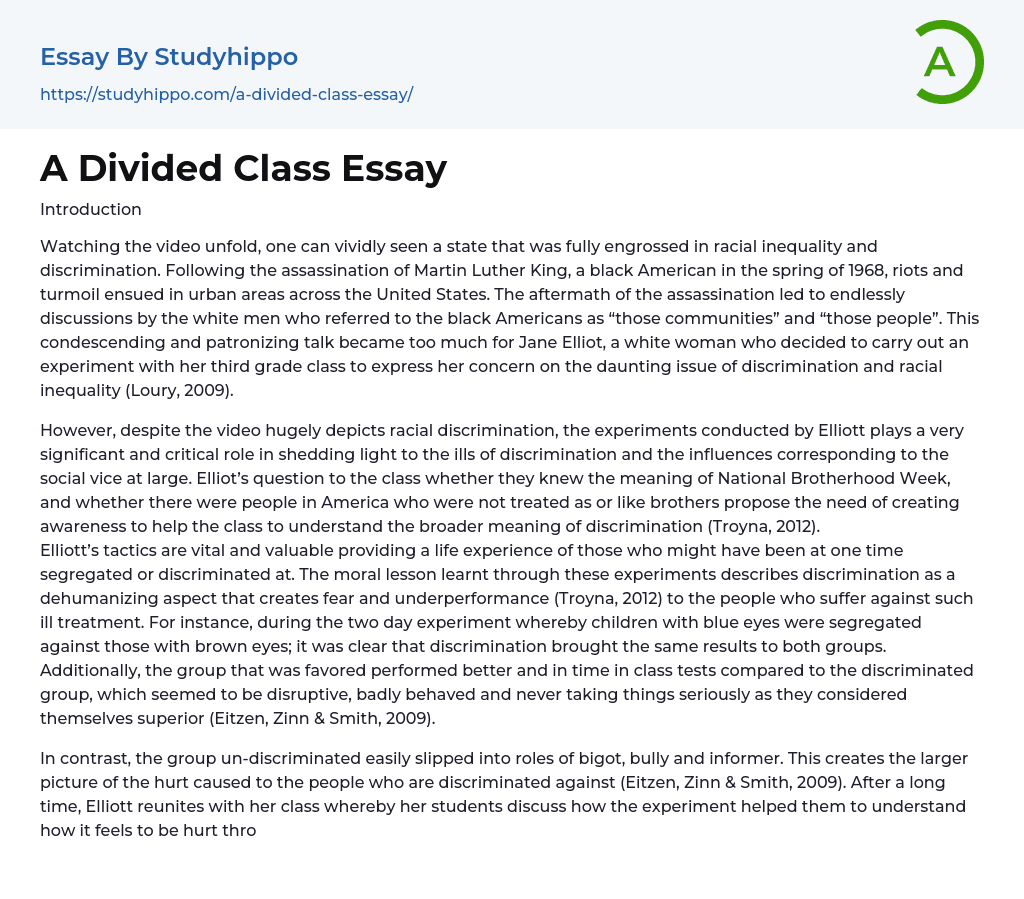Introduction
The video shows a state deeply affected by racial inequality and discrimination after the assassination of Martin Luther King in 1968. Following this event, riots and turmoil erupted in urban areas throughout the United States. The aftermath of the assassination sparked discussions among white men who referred to black Americans as “those communities” and “those people”, showing condescension and a patronizing attitude. Jane Elliot, a white woman, conducted an experiment with her third grade class in response to this issue of discrimination and racial inequality. This video demonstrates the significant role Elliot's experiments played in exposing the problems of discrimination and its social influences. Elliot asked the class if they knew the meaning of National Brotherhood Week and if there were people in America who were treated differently, highlighting the need for awareness to help the
...m understand the broader meaning of discrimination.
According to Troyna (2012), Elliott's tactics hold significant value and provide a real-life experience for individuals who have faced segregation or discrimination in the past. These experiments reveal that discrimination is dehumanizing and leads to fear and underperformance. In an experiment lasting two days, children with blue eyes were segregated from those with brown eyes, demonstrating that discrimination had negative effects on both groups. The favored group performed better on classroom tests and seemed to take their education more seriously, while the discriminated group showed disruptive behavior and a lack of seriousness, possibly due to feeling superior (Eitzen, Zinn & Smith, 2009).
In contrast, the group easily slipped into roles of bigot, bully and informer, causing hurt to the people who are discriminated against (Eitzen, Zinn & Smith, 2009). After
a long time, Elliott reunites with her class to discuss how the experiment helped them understand the experience of discrimination. This simulation is also carried out with prisoners and employees, yielding similar results. Therefore, Elliott's experiment is important for understanding the impacts of racial segregation and inequality (Troyna, 2012). Theorists, philosophers, and sociologists have contributed to establishing what is acceptable and important in the social world.
Different ideologies have been developed to explain human social life in a broader social context and how actions and interactions influence other situations or individuals (Mills, 2000). Elliott's methods of simulating discrimination effects demonstrate the sociological imagination. According to Mills (2000), the sociological imagination is the awareness of the relationship between personal experience and the larger society, enabling individuals to understand the historical scene. Elliott's various methods and experiments in the video contribute to raising awareness of social issues that hinder a country's development. The video "A Class Divided" sheds light on fundamental racial inequality problems.
According to Mills, the issues that can be identified involve determining which cherished values are under threat and which ones are supported. These issues encompass well-being, indifference, and uneasiness. Mills explains that when individuals cherish certain values and feel no threat to them, they experience a sense of well-being. Elliott's exercises highlight this concept by examining how society or authorities support the undiscriminated group while cherishing the values of superiority over their discriminated counterparts, thus leading to a sense of well-being. However, if individuals who hold these values feel threatened by racial inequality, they undergo a crisis.
The next concept arises when individuals are unaware of any cherished values or feel threatened. In this state,
they feel indifferent and are unaffected by segregation, discrimination, or freedom. However, if these individuals are unaware of cherished values but still feel threatened, they experience uneasiness. Additionally, racial inequality can be categorized into stereotypes, stigma, and justice (Loury, 2009). Racial stereotypes refer to the exaggerated beliefs that individuals have about all members of a specific racial group.
In terms of individual differences, people often ignore them and instead focus on information that aligns with their stereotypes about racial groups (Loury, 2009). These stereotypes can be harmful, leading to aggression, hatred, and a sense of superiority, ultimately leading to discrimination and racism. Racial stigma refers to how individuals perceive those from different racial groups, while racial justice revolves around treating all individuals equally. Racial stigma arises from the harm caused to individuals of a particular race due to the way they are treated.
Racial injustice causes individuals to be stigmatized based on their race (Loury, 2009).
References
- Eitzen D. Stanley, Zinn B. Maxine and Smith Kelly. (2013). Social Problems. Pearson (13th Edition), (0-576)
- Loury, G. C., ; Loury, G. C. (2009).
The book "The anatomy of racial inequality" by Harvard University Press is written by C. W. Mills (2000).
The sociological imagination. Oxford University Press.
Racial inequality in education is a topic discussed in the publication Taylor ; Francis.
- Agreement essays
- Business Law essays
- Common Law essays
- Community Policing essays
- Constitution essays
- Consumer Protection essays
- Contract essays
- Contract Law essays
- Copyright Infringement essays
- Court essays
- Crime essays
- Criminal Law essays
- Employment Law essays
- Family Law essays
- Injustice essays
- Judge essays
- Jury essays
- Justice essays
- Lawsuit essays
- Lawyer essays
- Marijuana Legalization essays
- Ownership essays
- Police essays
- Property essays
- Protection essays
- Security essays
- Tort Law essays
- Treaty essays
- United States Constitution essays
- War on Drugs essays
- Anthropology essays
- Audience essays
- Charity essays
- Cultural Competence essays
- Emile Durkheim essays
- Gender Roles essays
- Generation essays
- Globalization essays
- Interpersonal Relationship essays
- People essays
- Race essays
- Social Change essays
- Social Class essays
- Social Movement essays
- Social Science essays
- Social Status essays
- Social Stratification essays
- Society essays
- Sociological Imagination essays
- Sociological Perspective essays




